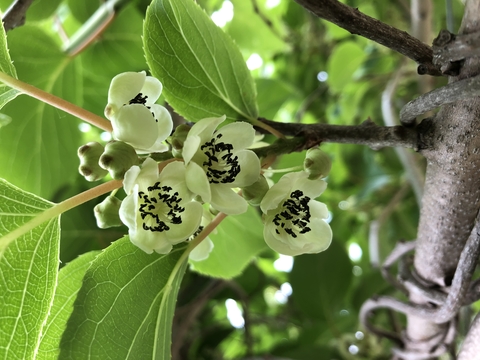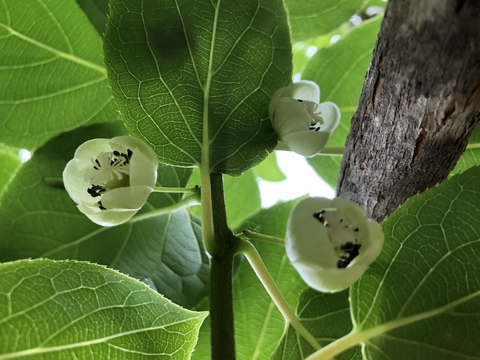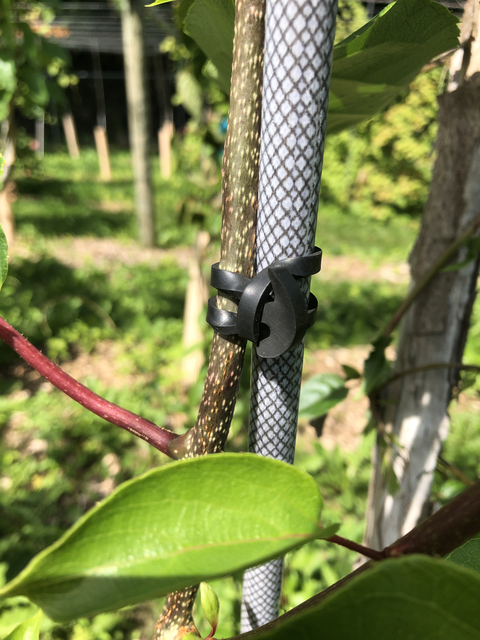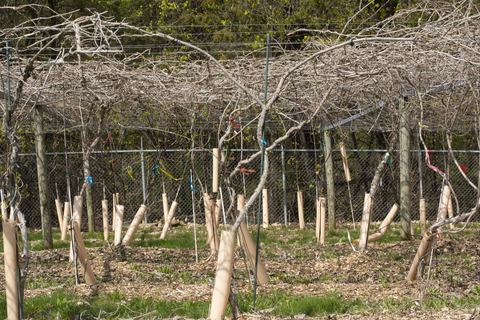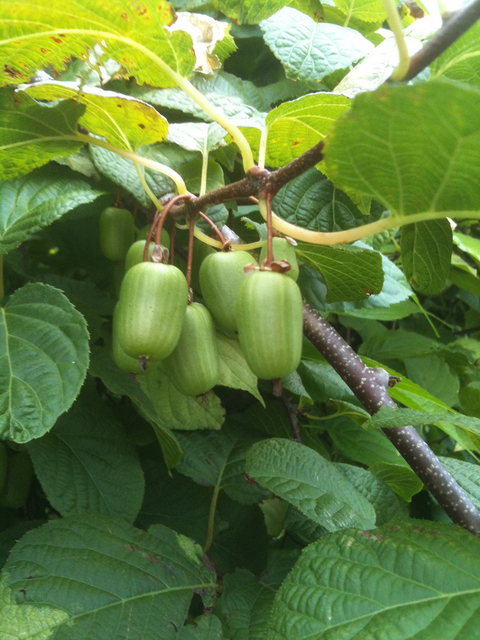Quick facts
- To produce fruit, plant at least one male plant for every six to eight female plants.
- Arctic Beauty, Actinidia kolomikta, is the best choice for Minnesota growers interested in planting for profit.
- Kiwiberry grows best in well-drained, aerated, moisture-retentive, slightly acidic soil.
- New vines take four to five years to train for production.
- Vines need to be pruned throughout the seasons.
- Kiwiberry vines need sturdy support for growth.
This page contains information for commercial fruit growers. If you are interested in growing kiwiberry in your home yard or garden, see Growing kiwiberry in the home garden.
Kiwiberry is an exciting new fruit crop for Minnesota, and many aspects of production are still in the research phase. We have compiled some region-specific production recommendations based on our research to date, and will continue to update information as we discover more.
Keep up with the latest kiwiberry research on the University of Minnesota Fruit Research site, and follow us on Instagram @umnfruit.
For general production information, take a look at resources developed by Oregon State University and the New Hampshire Agricultural Experiment Station.
Selecting kiwiberry plants
Kiwifruit is in the genus Actinidia, which includes about 80 species that are native to the forests of eastern Asia. Two species, Actinidia kolomikta and Actinidia arguta, can be grown for fruit in Minnesota and similar regions. These species have become known as kiwiberries because they produce grape-sized berries with a flavor similar to fuzzy kiwifruit, but a bit sweeter. Unlike the larger fuzzy kiwi, kiwiberries have thin, smooth skin and do not need to be peeled before eating.
A third species, Actinidia polygama, can also be grown in this region. The fruit has an unusual spicy, green-peppery flavor that some people find too strong.
Most kiwifruit plants are either male or female: the males supply the pollen and the females produce the berries. To get fruit you need at least one male plant for each six to eight female plants.
Several named varieties of each species are available, and new varieties will likely be available soon thanks to fruit breeding programs across the U.S.
Characteristics of kiwiberry species for Minnesota
| Actinidia kolomikta | Actinidia arguta | Actinidia polygama | |
|---|---|---|---|
| Common name | Arctic Beauty | Bower Berry | Silver Vine |
| USDA Winter Hardiness Zone | Zone 3 | Zone 4 | Zone 4 |
| Fruit flavor | Very good with a unique sweet-tart flavor and high-sugar content. | Excellent sweet-tart flavor, to over-fruity, to bland. Depends on variety. | Unripe fruit has unusual green pepper and spicy flavor. Ripe fruit is bland and unpleasant. |
| Harvest date | Mid-August to mid-September. Some as early as late July or as late as early October. | Late August to mid-October. | Mid- to late September. |
| Berry size | Small (2 to 8 grams) | Wide range (5 to 20 grams) | Small (3 to 10 grams) |
| Fruit yield | Up to 15 pounds per female vine | Up to 40+ pounds | Up to 15 pounds |
| Plant spacing | 10 to 20 feet apart | 20 to 30 feet apart | 10 to 20 feet apart |
| Varieties |
|
None recommended for commercial fruit production. | |
| Characteristics |
|
|
|
| Challenges |
|
|
|
Site, soil and mulch
In the wild, trees shade the trunks of kiwifruit vines. The tops of the plant receive sunlight by growing up into the forest canopy. Successful vine growth and fruit production in a cultivated setting can be achieved by imitating environmental conditions found in its native habitat.
- Plant vines in a location where they will be shaded from afternoon sun and winter sun, ideally north or east of a tree line, building or structure.
- This location will contribute to the cool, moist soil conditions favored by kiwiberry vine and will help delay bud break in the spring.
- A treeline also provides protection from strong winds and helps protect tender shoots during spring growth.
- Diagrams showing regional wind patterns in each month are available online for many areas across Minnesota. Use these diagrams to determine the direction and speed of prevailing winds.
- The selected location should also allow for air drainage (sloping ground). Avoid low-lying areas that can become frost pockets.
Kiwiberry grows best in well-drained, aerated, moisture-retentive soil, that is rich in organic matter and slightly acid to neutral (pH 5.5 - 7.5).
Use a 4-inch thick layer of mulch to retain moisture, regulate soil temperatures, control weeds and encourage healthy root growth. In the spring, the cooler soil temperatures beneath the mulch layer can delay budbreak and reduce the potential for spring-freeze injury.
Compared with plants grown in bare soil, A. kolomikta grown under a thick layer of mulch tends to have a much more laterally extensive and denser fine root system. Many of these roots are distributed along the mulch-soil interface and can extend several feet out from the trunk.
Recommended mulch materials:
- Wood chips
- Leaf mulch
- Corn stover
Training and pruning
Kiwiberry vines need sturdy support for growth. The vine twists counterclockwise around support structures, and the vigorous growth becomes very heavy by mid-season.
Vines can be trained to a pole or tree stake and then onto a trellis structure, such as a T-bar or pergola. Both T-bar and pergola trellis systems use high-tensile steel wire to support the vegetative canopy.
T-bar system benefits
- Simpler - it can fit into the row structure of a larger diversified orchard and allow for some mechanization.
- Offers lower humidity which may reduce incidence of sooty blotch or flyspeck.
Pergola trellis structure benefits
- Higher fruit production with a lower incidence of berry rub marks.
- Easier harvest because the berries hang down from the overlying vegetative canopy.
- Maintains cool, moist soil conditions once the foliage canopy is established.
- Less weed growth because of the shade.
- Less suckering at the base of the trunk because of the shade.
New vines take four to five years to train for production. Vines with an established root system that need to be regrown and trained because of winter injury may take one to three years to train.
First growing season
- Transplant bare-root or container-grown vines early in the spring after the risk of frost is past.
- This will allow the root system to become well-established before winter, and will promote vegetative growth the following year.
- Most vegetative growth occurs in late spring to early summer.
- Rapid growth ends earlier for A. kolomikta compared to A. arguta.
- You can also plant dormant vines in the fall before the soil freezes.
Second growing season
- In the spring, look for a thick and vigorous shoot that is about the thickness of a pencil emerging near the base of the trunk.
- In late June, once this shoot starts to become woody, prune away all other growth to leave this single shoot. This will become the vine’s main trunk.
- Loosely secure the shoot about one foot below the growing tip to the support stake and allow it to grow for the remainder of the season, or until it reaches the trellis wire above.
- Pinch back the growing tip to encourage the development of a secondary side shoot.
- This second shoot should be located about two thirds of the way up the trunk to the trellis wire to form a “Y” configuration at the split.
- These will become the two main branches, or cordons.
Third growing season
- Cross the two cordons past one another so one cordon arm of the “Y” goes from the 2:00 position to 10:00, while the other cordon arm of the “Y” goes from 10:00 to 2:00.
- As growth progresses loosely tie the two cordons to the trellis wire.
- Allow secondary shoots to emerge and grow out from the two cordons at uniformly spaced intervals of 8 to 12 inches.
- Snip off any side shoots that appear lower down on the trunk.
- Remove any vigorous “explorer shoots” that may emerge from the cordon since these will not produce flowers or fruit, and will crowd the canopy.
Fourth growing season
- Tie down the secondary canes to the support wires.
- Specialized plastic vine buckle clips keep the shoots in place and will keep them from shifting.
- Flower-bearing shoots are recognized by their closely-spaced buds.
- These shoots will carry the fruit crop (for female plants) in the following year.
Fifth season and beyond
Prune out old secondary canes and tie down new secondary canes that formed during the preceding growing season.
Much of the vegetative growth occurs during the spring and early summer. Left unchecked, vines can grow into a tangled mess within a few seasons. In Minnesota, pruning is done in three seasons, and each season’s pruning is a little different.
Mid- to late autumn
Major pruning should be done at this time of year, once the soil begins to freeze. At this time, cuts on exposed wood will have the opportunity to dry out over the winter and reduce the potential for sap flow, or “bleeding” in the spring.
Late winter
It is ideal to do dormant pruning in late fall before heavy snowfall. But if pruning isn’t completed in late fall, it can also be done in late winter. Prune while the soil is still frozen.
Pruning cuts made at this time of year will be subject to profuse sap-flow “bleeding." Prevent this by painting the cut areas with latex paint on a day when air temperatures are expected to remain above freezing for several hours so the paint can dry.
Spring and early summer
- Pruning at this time of year consists mostly of shearing, shaping, thinning and training to retain the desired plant architecture.
- Kiwifruit plants store starch in the woody tissue of the vine canopy, and these starches are converted to sugar and translocated to the roots.
- Any pruning that has not been done by mid-July should be delayed until the fall when the soil begins to freeze.
Vineyard management
Supplemental watering will be needed during most Minnesota summers as drought-stressed plants are prone to smaller fruit, lower yields and premature berry drop. Drought stress also makes plants much more susceptible to winter cold injury.
We do not yet have specific soil recommendations for kiwiberries, but these general guidelines have been successful in research trials:
- Kiwiberry benefits from the application of fertilizer containing nitrogen and potassium.
- Light applications should be broadcast around the trunk area from the spring after the soil thaws into late June.
- Most Minnesota soils have adequate phosphorus for plant growth.
- If a soil test shows a lack of phosphorus, be sure to use a complete fertilizer.
- Wood chip mulch will generally not tie up nitrogen unless the wood chips were incorporated into the soil during planting.
- The woodchips will need to be replenished every few years to maintain a substantial cover.
- The berries begin to ripen in late July, and harvest may extend into late September and October.
- Cool night temperatures facilitate ripening.
- Immature berries are hard, opaque and glossy.
- As they ripen, the berries become dull, translucent and soft when gently squeezed.
- Berries for many A. kolomikta varieties may also develop vertical stripes that are slightly yellowish in appearance.
- Once the berries start to ripen, it is time to pick all of them.
- Like fuzzy kiwifruit, they are best eaten fresh and can be refrigerated for a week or two.
- To increase storage life, separate the firm berries from the soft ones and remove all debris and damaged fruit.
- Place the firm berries in special plastic fruit storage bags designed to absorb fruit-ripening ethylene gas. These can be found in many grocery stores and online.
Managing pests and challenges
Insect damage is rare on kiwiberry, though Spotted Wing Drosophila may appear where overripe fruit is left on the vine or on the ground. Pick all the fruit during harvest, and remove any fruit that falls to the ground.
Rabbits and deer can cause problems to the trunk and foliage.
- Rabbits chew on the bark in fall and winter and may completely girdle the vine's trunk.
- Surround the trunks with fencing taller than the expected snow depth to protect from rabbit damage.
- Deer may browse kiwiberry leaves throughout the growing season until the vines reach a height where the deer can no longer reach the foliage.
Aside from the root rots common to kiwifruit in poorly drained soil, there are no significant diseases to worry about when growing kiwiberry.
- Prevent root rot by planting vines in well-drained soil, and be sure not to over-water.
- Do not plant near black walnuts or hickories as juglones in the soil derived from those trees will kill the vines.
In late winter, the warmth of the sun combined with the reflection off the snow surface heats up the wood tissue in the vine's trunk. After sunset, the temperature cools quickly and refreezes this tissue. That rapid thaw and freeze cycle can result in death of cambium-layer tissue under the bark and lead to cracking of the trunk, severely damaging the vine. This is called sunscald injury, and may be important for small scale growers.
- All young vines are susceptible to sunscald because of their thin bark.
- A. kolomikta vines of all ages are susceptible because of their dark-colored bark that readily absorbs heat.
- Mature vines of A. arguta develop a thick, shaggy bark. Once mature, these vines are not as prone to sunscald and do not need as much protection from winter sun.
Ways to protect vines from sunscald:
- Place a shade barrier on the south and southwest sides of the vine’s trunk to protect from sunscald if insufficient shade is available.
- Use plastic spiral wraps, split grow-tubes, full grow tubes or tree shelters around the trunk.
- If using split grow-tubes, the split side should be placed on the north side of the trunk and secured at the top to keep them from blowing off in strong winds.
Spiral and full grow tubes or tree shelters can also prevent rabbit damage in winter. Split tubes do not protect the vines from rabbit damage, since the animals can access the trunk from the open side.
History of kiwifruit production in the Upper Midwest
Cold-hardy kiwifruit has been grown in Minnesota since the late 1800s. In one of the earliest accounts from 1892, Samuel B. Green, the University of Minnesota’s first Professor of Horticulture wrote:
A. arguta, wrongly called A. polygama – a rampant growing ornamental vine from Japan. This has been grown in a small way by R. J. Mendenhall, of Minneapolis, [in the area around present-day Lake St. and Nicollet Ave] and has been found to be unreliable. At the experiment station we lost ours the first winter it was planted.
The non-cold hardy Japanese plants likely originated from one of Professor Green’s instructors at the Massachusetts Agricultural College (MAC), now the University of Massachusetts, where Professor Green received his degree in 1879. MAC President and Professor of Botany and Horticulture, William S. Clark, brought back seeds of A. arguta and A. polygama that he and his students collected in the forests and markets near Sapporo, Japan in 1876 and 1877.
Upon his return a year later these seeds were distributed to various horticultural societies, contacts and academic institutions including Harvard’s Arnold Arboretum (1876) and Michigan State University (1878). Plants were growing in Iowa by 1884.
After the first experiments with the fruit in the 19th century, kiwiberry research continued in the 20th century. In 1902, Professor Joseph L. Budd at Iowa State University wrote:
Actinidia arguta - This is a peculiarly rampant growing vine from Japan, with a tropical expression of foliage. Where hardy east of the [Great] lakes and in the South, it will cover a fence, arbor, or trellis in less time than any vine known to the writer. In the West, north of the 42nd parallel, [the latitude for Ames, Iowa] it is not hardy enough for a permanent covering of arbor or porch; but in less important positions, if cut back severely when injured, it soon regains what it has lost, with added beauty of the new growth.
In 1905 Professor Green wrote regarding vines growing on the St. Paul campus farm:
Actinidia arguta - A rank growing climbing plant from Japan. Foliage large, handsome, has never flowered at the University Farm but has held on well and made a vigorous growth each year. We cannot advise planting as there are more desirable vines.
In 1905, Professor Green did not have access to more cold-tolerant genetic stock. At the St. Paul campus, minimum winter temperatures during the preceding two winters were -33° F and -26° F and it is likely that the Japan-derived plants that he was growing at that time were killed back to the snowline. In Minnesota, A. arguta typically requires a minimum of two consecutive mild winters in order to flower, because mid-winter temperatures below -25° F can cause vascular injury for most varieties of this particular species.
USDA-sponsored plant explorations in Russia and China during the first two decades of the 20th century introduced more cold-hardy plant material to North America. After Professor Green’s death in 1910, the Minnesota Experiment Station did not perform further evaluations of kiwiberries until the mid-1980s.
In Ottawa, Canada (USDA Hardiness Zone 3b) the most cold-hardy of the kiwifruit species, A. kolomikta, was planted in 1897 and reported two years later as being hardy. In 1931 at the Morden Arboretum in Manitoba (USDA Hardiness Zone 3a), A. kolomikta was reported to be hardy enough to survive the winters of southern Manitoba. Three Russian accessions obtained and planted in 1962 were still growing at Morden in 1970.
Funding for this publication was provided by the Minnesota Department of Agriculture (MDA) and made possible by the U.S. Department of Agriculture's (USDA) Agricultural Marketing Service through grant No. AMI170100XXXXG008. Its contents are solely the responsibility of the authors and do not necessarily represent the official views of the USDA or MDA.
Reviewed in 2019


